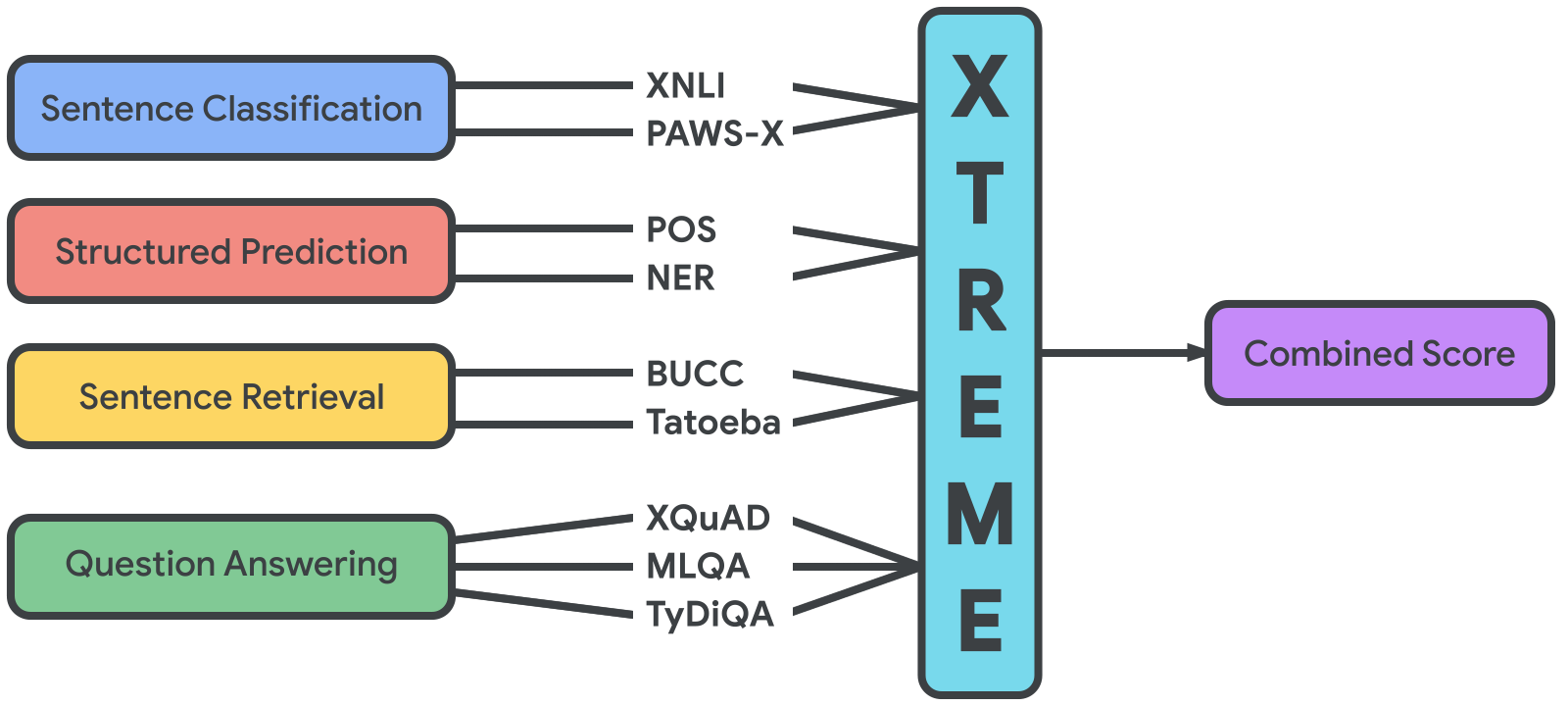Tasks | Download | Baselines | Leaderboard | Website | Paper
This repository contains information about XTREME, code for downloading data, and implementations of baseline systems for the benchmark.
The Cross-lingual TRansfer Evaluation of Multilingual Encoders (XTREME) benchmark is a benchmark for the evaluation of the cross-lingual generalization ability of pre-trained multilingual models. It covers 40 typologically diverse languages (spanning 12 language families) and includes nine tasks that collectively require reasoning about different levels of syntax and semantics. The languages in XTREME are selected to maximize language diversity, coverage in existing tasks, and availability of training data. Among these are many under-studied languages, such as the Dravidian languages Tamil (spoken in southern India, Sri Lanka, and Singapore), Telugu and Malayalam (spoken mainly in southern India), and the Niger-Congo languages Swahili and Yoruba, spoken in Africa.
For a full description of the benchmark, see the paper.
The tasks included in XTREME cover a range of standard paradigms in natural language processing, including sentence classification, structured prediction, sentence retrieval and question answering. The full list of tasks can be seen in the image below.
In order for models to be successful on the XTREME benchmark, they must learn representations that generalize across many tasks and languages. Each of the tasks covers a subset of the 40 languages included in XTREME (shown here with their ISO 639-1 codes): af, ar, bg, bn, de, el, en, es, et, eu, fa, fi, fr, he, hi, hu, id, it, ja, jv, ka, kk, ko, ml, mr, ms, my, nl, pt, ru, sw, ta, te, th, tl, tr, ur, vi, yo, and zh. The languages were selected among the top 100 languages with the most Wikipedia articles to maximize language diversity, task coverage, and availability of training data. They include members of the Afro-Asiatic, Austro-Asiatic, Austronesian, Dravidian, Indo-European, Japonic, Kartvelian, Kra-Dai, Niger-Congo, Sino-Tibetan, Turkic, and Uralic language families as well as of two isolates, Basque and Korean.
In order to run experiments on XTREME, the first step is to download the dependencies. We assumed you have installed anaconda. The additional requirements including transformers, seqeval (for sequence labelling evaluation), tensorboardx, jieba, kytea, and pythainlp (for text segmentation in Chinese, Japanese, and Thai), and sacremoses can be installed by running the following script:
bash install_tools.sh
The next step is to download the data. To this end, first create a download folder with mkdir -p download in the root of this project. You then need to manually download panx_dataset (for NER) from here (note that it will download as AmazonPhotos.zip) to the download directory. Finally, run the following command to download the remaining datasets:
bash scripts/download_data.sh
The evaluation setting in XTREME is zero-shot cross-lingual transfer from English. We fine-tune models that were pre-trained on multilingual data on the labelled data of each XTREME task in English. Each fine-tuned model is then applied to the test data of the same task in other languages to obtain predictions.
For every task, we provide a single script scripts/train.sh that fine-tunes pre-trained models implemented in the [Transformers] repo. To fine-tune a different model, simply pass different MODEL argument to the script with the corresponding model, where the current supported models are bert-base-multilingual-cased, xlm-mlm-100-1280 and xlm-roberta-large.
For part-of-speech tagging, we use data from the Universal Dependencies v2.5. You can fine-tune a pre-trained multilingual model on the English POS tagging data with the following command:
bash scripts/train.sh [MODEL] udpos
For named entity recognition (NER), we use data from the Wikiann (panx) dataset. You can fine-tune a pre-trained multilingual model on the English NER data with the following command:
bash scripts/train.sh [MODEL] panx
For sentence classification, we use the Cross-lingual Paraphrase Adversaries from Word Scrambling (PAWS-X) dataset. You can fine-tune a pre-trained multilingual model on the English PAWS data with the following command:
bash scripts/train.sh [MODEL] pawsx
The second sentence classification dataset is the Cross-lingual Natural Language Inference (XNLI) dataset. You can fine-tune a pre-trained multilingual model on the English MNLI data with the following command:
bash scripts/train.sh [MODEL] xnli
For question answering, we use the data from the XQuAD, MLQA, and TyDiQA-Gold Passage datasets. For XQuAD and MLQA, the model should be trained on the English SQuAD training set. For TyDiQA-Gold Passage, the model is trained on the English TyDiQA-GoldP training set. Using the following command, you can first fine-tune a pre-trained multilingual model on the corresponding English training data, and then you can obtain predictions on the test data of all tasks.
bash scripts/train.sh [MODEL] [xquad,mlqa,tydiqa]
For cross-lingual sentence retrieval, we use the data from the Building and Using Parallel Corpora (BUCC) shared task. As the models are not trained for this task but the representations of the pre-trained models are directly used to obtain similarity judgements, you can directly apply the model to obtain predictions on the test data of the task:
bash scripts/train.sh [MODEL] bucc2018
The second cross-lingual sentence retrieval dataset we use, is the Tatoeba dataset. Similarly to BUCC, you can directly apply the model to obtain predictions on the test data of the task:
bash scripts/train.sh [MODEL] tatoeba
To submit your predicitons to XTREME, please create one single folder that contains 9 sub-folders named after all the tasks, i.e., udpos, panx, xnli, pawsx, xquad, mlqa, tydiqa, bucc2018, tatoeba. Inside each sub-folder, create a file containing the prediction label of the test set for all languages, and name the file using the format test-{language}.{extension} where language indicates the 2-character language code, and extension is json for QA tasks and tsv for other tasks.
We will compare your submissions with our label files using the following command:
python evaluate.py --prediction_folder [path] --label_folder [path]
If you use our benchmark or the code in this repo, please cite our paper.
@article{hu2020xtreme,
author = {Junjie Hu and Sebastian Ruder and Aditya Siddhant and Graham Neubig and Orhan Firat and Melvin Johnson},
title = {XTREME: A Massively Multilingual Multi-task Benchmark for Evaluating Cross-lingual Generalization},
journal = {CoRR},
volume = {abs/2003.11080},
year = {2020},
archivePrefix = {arXiv},
eprint = {2003.11080}
}
